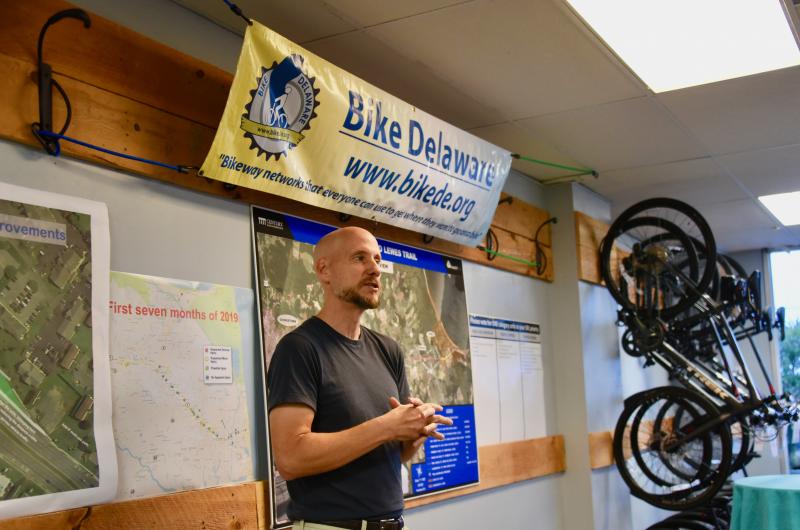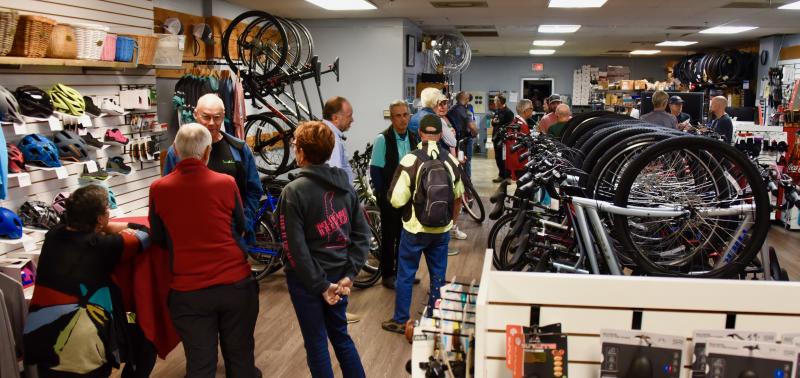Delaware has invested in making the state a top destination for cyclists, but that effort brought with it a new problem. For cyclists, Route 1 in the Cape Region is now the most dangerous road in the state.
Bike Delaware is now surveying cyclists across the state to gather input on local and statewide bicycling issues through a series of Shop Talk events.
“There is no community in Delaware with a more positive and optimistic story to tell about cycling than Lewes. At the same time, only a mile outside of Lewes' city limits, the single most dangerous segment of road for cyclists anywhere in the state has had dozens of crashes involving bicycles,” said Bike Delaware Executive Director James Wilson.
He was addressing cyclists who gathered Oct. 28 at Lewes Cycle Sports.
There was a reason Bike Delaware started its initiative in Lewes. Wilson said the only other city in the state that even comes close to Lewes in popularity of cycling and trail use is Newark. “You talk about conflicts on the trails, but that shows the trails are full of people. That's not the case throughout the state,” he said.
“I know there is a lot of passion for safety on trails, but the bigger issue is Route 1,” he said.
He said 2003 was the last time transportation officials looked at bicycle and pedestrian issues along the corridor. On Route 1, cyclists, buses and vehicles making right turns share a lane.
He said this year there have been more than 20 bicycle-vehicle crashes along Route 1, including one that cost the life of experienced Lewes cyclist Jay Kirby at the Kings Highway intersection. Another cyclist was killed on Route 1 in Bethany Beach. “We will continue to see minor crashes and even fatalities without changes,” he said.
Wilson especially wanted input on Route 1 from the Lewes group.
He urged those attending to select a priority for Bike Delaware to focus on for improvements along Route 1, including road-use behavior, traffic control or physical design. “We want to know what is most important to pursue to improve safety on Route 1,” he said.
Bike Delaware, a nonprofit agency, advocates for safe, convenient and fun cycling and walking for state residents.
DelDOT: Transportation paths
Wilson said the reason all trails designed by Delaware Department of Transportation are paved is because the trails are considered alternative transportation routes. “They are all paved and built for transportation and open 24 hours a day. If you go to DelDOT as a recreational cyclist, you'll get no traction,” he said. “They will tell you they are in the transportation business. You have to lead with transportation to get in the door. Our advocacy aims at using bikes for transportation.”
He said many of the issues expressed recently about the Lewes-to-Georgetown Trail, including concern with crossings at intersections, can be resolved with infrastructure improvements. Wilson said beacon signals and better road markings are ideas. “You need to look for infrastructure solutions for specific spots. There is a toolbox; there are solutions,” he said.
Word out about bike rules
Others asked about confusion about rules of the road concerning bicycles and vehicles. Wilson said the Delaware driver's manual has been updated to include recent changes in the laws. “Delaware is the No. 1 state in spending money for paths and has the most pro-bike rules in the country,” he said.
Even so, all agreed people do not understand the rules of the road.
John Kurpjuweit, Sussex Cyclists president, said the group is designing bike hangers listing bike laws and safe places to ride to be distributed to area bike shops to hang on bikes they sell. The group is also designing rack cards with the same information.
Sussex Cyclists conducted 22 bike safety stops this year handing out helmets and putting lights on bicycles. In addition, rules of the road brochures are printed in several languages.
Asked about a bicycle law awareness campaign, Wilson said the Office of Highway Safety has another priority. “We are the second deadliest state per capita with pedestrian deaths. That's where they are focused,” he said.
Action in Lewes
Don Long, chairman of the Lewes Bicycle and Pedestrian Advisory Committee, said the group, with city and police support, has been proactive in promoting safety and awareness. Events include bike rodeos with young riders and a recent pop-up event at the Lewes library to install bike bells. “We did 50 on the first day and will do it again,” he said.
He said Lewes police have continued to hand out free ice cream tickets to young cyclists who they see wearing helmets.
Long said the city experiences a serious bicycle parking problem in the summer with illegally parked bikes. He said it's common to see cyclists riding the wrong way and on sidewalks. He also said Cedar Street is an area of concern during the summer because so many cyclists use it, but the street is used for beach parking. “We are Bicycle Friendly, but not so much in summer time,” he said.
Foreign students on bikes
Several in attendance asked about J-1 foreign students who bike on Route 1 during the tourist season, many who ride without helmets and at night without lights.
Bruce Kaufmann, who heads the Intentional Student Outreach program's bicycling program, said nearly 200 bikes were given to students this year. But, he said, there were more than 1,000 J-1 students working in the area.
He said in order to get a bike, students must take part in a bike rodeo with the police and take a short class on rules of the road and the reality of riding on Route 1. During the summer at church dinners, bike helmets and lights are provided to students.
“We are only reaching 20 percent of the students. It would be better for DART to provide cheap bus tickets so they don't have to ride at all. As a cyclist I hate to say that. Riding on the highway is the only way they have to get to work,” he said.
Updates on projects
Wilson informed the group that construction of Phase 3 of the Lewes-to-Georgetown Trail is expected to begin next summer or fall, from Georgetown to the Park Avenue area near Delaware Coastal Airport. The first two phases of the trail have been completed in the Lewes area from Gills Neck Road to Log Cabin Hill Road west of Sweetbriar Road.
He said a DelDOT contractor has finished maintenance work on the trail, which included cutting back vegetation at least 50 feet back from all intersections to allow for better visibility for motorists approaching the trail, as well as better views for trail users at intersections.
Wilson said Delaware River and Bay Authority officials have budgeted funds to explore the possibility of constructing a separate bicycle-pedestrian pathway over the Freeman Highway Bridge.
Bicycle-vehicle crashes on Route 1*
48 percent on sidewalks
29 percent on bike lanes
17 percent crossing the highway
6 percent unknown
* Incidents generating a police report
Paths to safer Route 1 cycling
Road-use behavior – Education, signage, billboards, more police enforcements
Traffic control – New pavement markings, lane separators, signal timing changes, intersection modifications
Physical design – Create separated pathways for bicyclists and pedestrians, create access streets for local, low-speed traffic to access Route 1, land purchase for improvements
Among bicycle rules
Cyclists must ride with traffic; pedestrians walk against traffic
Cyclists under 18 years of age are required to wear helmets
Front and rear lights are required at night
Cyclists are permitted to ride both ways on Route 1 sidewalks; cities and towns set their own rules






















































